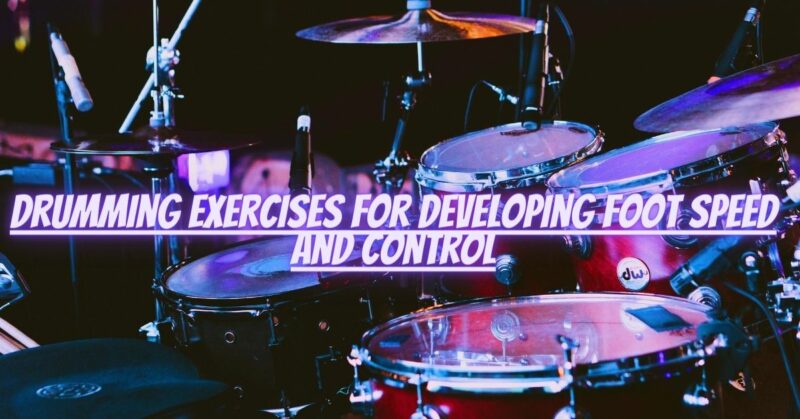Developing speed and control in your footwork is crucial for drummers looking to deliver fast and precise bass drum patterns. Whether you’re playing intricate double bass patterns in metal or driving the groove in funk or rock, improving your foot speed and control will enhance your overall drumming performance. In this article, we will explore a series of drumming exercises specifically designed to develop foot speed and control. By incorporating these exercises into your practice routine, you can strengthen the muscles, improve coordination, and unlock the ability to execute lightning-fast and accurate bass drum techniques.
- Single Stroke Technique: Begin by practicing single strokes with your bass drum pedal. Play alternating single strokes with each foot, starting at a comfortable tempo. Gradually increase the speed while maintaining control and consistency in each stroke. Focus on relaxed ankle movements and letting the pedal rebound naturally. This exercise builds endurance and coordination in your footwork.
- Double Stroke Technique: Developing control and speed in your double strokes is essential for executing rapid bass drum patterns. Practice playing double strokes with each foot by employing the heel-toe technique. Start slowly, focusing on clean and even double strokes. Gradually increase the speed, ensuring each stroke sounds distinct and even. This exercise enhances your foot control and speed.
- Pedal Slides: Pedal slides are an effective exercise for developing foot control and accuracy. Start by playing single strokes with your foot, then slide your foot back and forth on the pedal between strokes. Begin at a comfortable tempo and gradually increase the speed. Focus on maintaining control and accuracy in each stroke and slide. This exercise improves your foot control and fluidity.
- Flam Technique: Flam exercises can also be applied to the bass drum for developing foot control and speed. Practice playing flam accents with your bass drum pedal, where the primary stroke is slightly accented and the grace note is played softer. Begin at a moderate tempo and gradually increase the speed while maintaining clarity and control. This exercise enhances your foot control and adds dynamic range to your bass drum playing.
- Single Pedal Speed Bursts: Speed bursts are short bursts of fast and controlled bass drum strokes. Start by playing a set number of strokes (e.g., 16 or 32) as fast as possible while maintaining control and evenness. Focus on generating speed primarily from your ankle and foot movements, allowing the pedal to rebound efficiently. Practice speed bursts at various tempos, gradually increasing the speed over time.
- Syncopated Patterns: Practicing syncopated bass drum patterns helps develop foot coordination and control. Play patterns that include offbeat accents, syncopated rhythms, or syncopated double strokes. Start slowly, focusing on accuracy and control, then gradually increase the speed. Pay attention to the placement of each stroke and ensure a consistent and controlled sound.
- Independence Exercises: Developing foot independence is essential for playing complex drum patterns. Practice exercises that involve playing different rhythms with your feet and hands simultaneously. For example, play a simple snare drum pattern with your hands while playing various bass drum patterns with your feet. Start slowly and gradually increase the complexity and speed of the patterns. This exercise enhances your foot coordination and control.
- Double Bass Drum Patterns: If you have a double bass drum pedal, incorporate double bass drum patterns into your practice routine. Practice playing patterns that involve alternating strokes between both feet or playing different rhythms with each foot. Start slowly, focusing on accuracy and control, and gradually increase the speed and complexity of the patterns. This exercise improves your foot independence, coordination, and speed.
- Practice with a Metronome: Incorporate a metronome into your practice routine to develop a strong sense of timing and to track your progress. Start at a comfortable tempo and gradually increase the speed as your foot speed improves. Use the metronome as a guide to maintain a consistent tempo and challenge yourself to push beyond your comfort zone.
Conclusion: Developing foot speed and control requires dedicated practice, focused technique, and patience. By incorporating exercises such as single stroke and double stroke techniques, pedal slides, flam techniques, single pedal speed bursts, syncopated patterns, independence exercises, double bass drum patterns (if applicable), and practicing with a metronome, you can develop the necessary speed, control, and coordination in your footwork. Remember to maintain relaxed ankle and foot movements, focus on technique and accuracy, gradually increase the tempo, and practice consistently. With perseverance and dedication, you can unlock impressive foot speed and control, elevating your drumming and delivering powerful and precise bass drum patterns.


